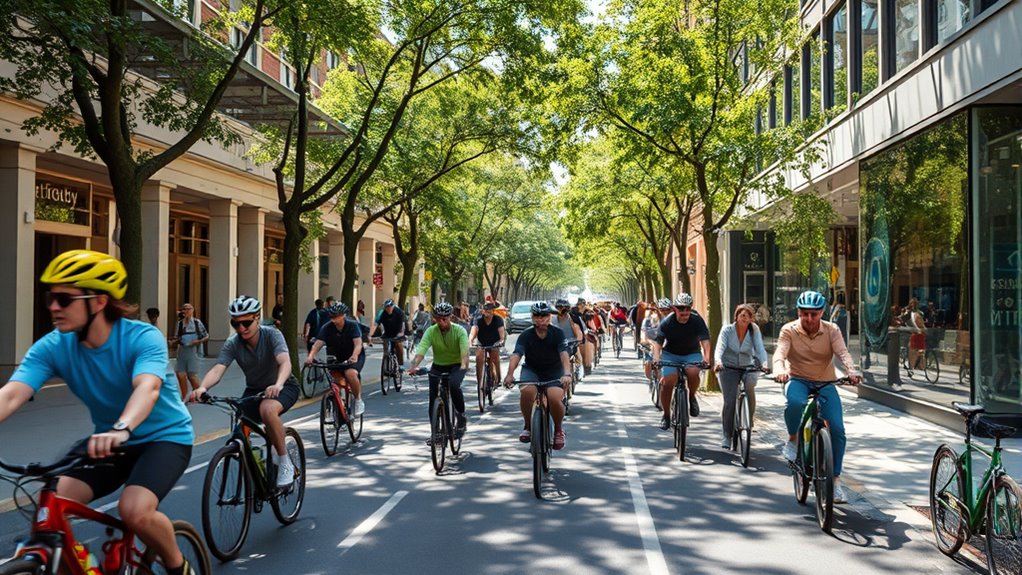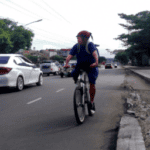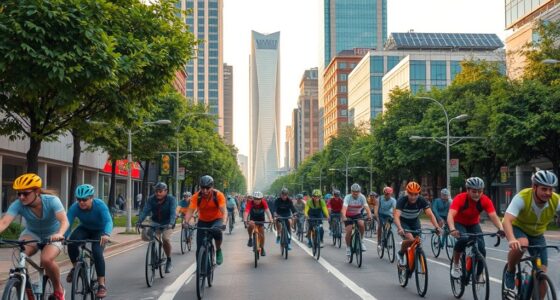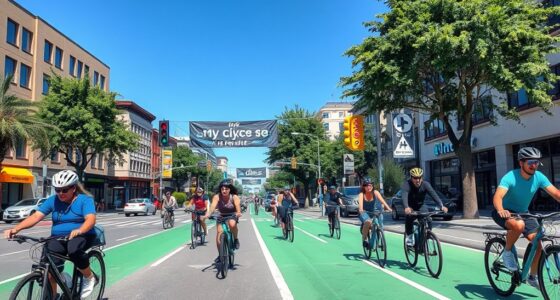Temporary street closures can disrupt traffic flow, but they also open up opportunities for you to enjoy safer, less congested cycling routes. As car traffic reroutes, bike lanes may expand or new ones may appear, making your rides more comfortable and secure. These closures often serve as testing grounds for future bike-friendly infrastructure that benefits cyclists long-term. Keep exploring, and you’ll discover how these temporary changes can lead to lasting improvements for urban biking.
Key Takeaways
- Temporary street closures reroute traffic, creating safer, less congested cycling conditions and opportunities for infrastructure improvements.
- These closures enable the expansion and testing of new bike lanes and cycling infrastructure.
- Cyclists benefit from smoother rides, safer routes, and the chance to explore new urban areas.
- Temporary closures serve as pilots for permanent bike-friendly infrastructure and help gather community feedback.
- They encourage community engagement, promoting long-term development of accessible, safe cycling environments.
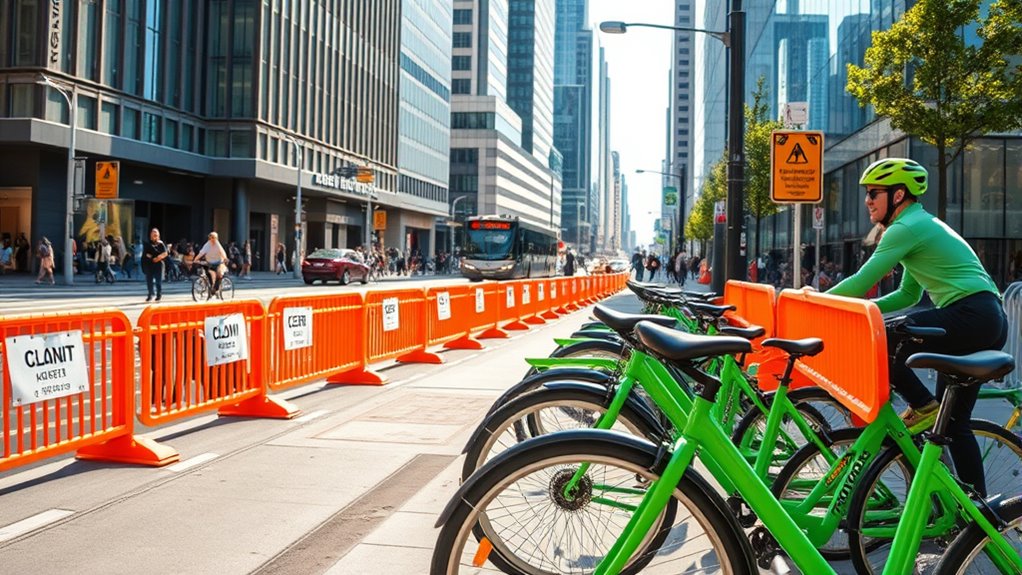
Temporary street closures often disrupt traffic flow, but they can also create opportunities for cyclists to enjoy safer, more accessible routes. When city officials decide to close streets temporarily, they usually aim to reduce congestion, improve safety, or prepare for events. During these closures, traffic is rerouted, often shifting vehicles onto alternative routes. While this can cause some initial frustration, it opens a window for cyclists to explore new pathways, especially if the closures include bike lane expansion plans.
Bike lane expansion becomes more feasible during these periods because streets are less crowded with motor vehicles. City planners sometimes take the opportunity to widen existing bike lanes or add new ones, making cycling safer and more appealing. With fewer cars on the road, you can enjoy a smoother ride and better separation from motor traffic. These temporary changes often include designated cycling corridors that weren’t available before, giving you safer routes to commute or explore the city.
Traffic rerouting during street closures can be both a challenge and an advantage. On one hand, detours might mean longer travel times if you’re on a bike, but on the other, they can lead you through quieter streets or scenic routes that are typically overwhelmed by traffic. City officials often design rerouting plans that prioritize cycling infrastructure, which means you might find yourself taking a more direct or safer path than usual. This can encourage you to discover new parts of your city and develop a more confident cycling routine.
Moreover, these closures often serve as pilots for future permanent infrastructure improvements. When you see a street closed off temporarily and dedicated bike lanes added in its place, you get a glimpse of what could become the norm. It’s an opportunity for city leaders to test out new configurations, gauge public response, and decide if these changes should stay. Your feedback, along with increased cycling activity during these periods, can influence the decision to make bike lane expansion permanent.
In addition, temporary street closures can foster community engagement by encouraging residents to participate in planning discussions about urban infrastructure improvements.
In essence, temporary street closures, while disruptive at first glance, can profoundly benefit cyclists like you. They promote safer, more accessible routes by expanding bike lanes and rethinking traffic routing. As a cyclist, you gain more space, improved safety, and new routes to explore. These temporary measures often pave the way for lasting improvements, making your city more bike-friendly in the long run. Embracing these changes can turn a potential inconvenience into an opportunity to ride more freely and confidently through your urban landscape.
Frequently Asked Questions
How Are Bike Routes Affected During Street Closures?
During street closures, your bike routes are often affected by detour planning and signage updates. You’ll need to follow posted detour signs that guide you around the closure, which might extend your travel time. Keep an eye out for updated signage indicating alternative bike paths or lanes. Planning ahead helps you stay safe and avoid confusion, ensuring you can still reach your destination efficiently despite the temporary changes.
What Safety Measures Are in Place for Cyclists?
You’re protected by safety measures like clear bike lane markings that guide you safely through streets, especially during closures. Wearing a helmet is essential for helmet safety, reducing injury risk if you fall. Additionally, barriers and signs are often put in place to alert you of detours or hazards. Stay alert, follow markings, and always wear your helmet to stay safe while cycling around temporary street closures.
Can I Still Access Bike-Sharing Programs During Closures?
During street closures, you can usually still access bike-sharing programs, but be aware that some stations might be temporarily unavailable. Imagine finding a bike parking spot amidst the bustling city, even if a few racks are blocked. Maintenance stations may be nearby to keep your ride smooth. Check the app or website for real-time updates, so you can plan your ride and find alternative parking or stations during closures.
How Long Do Typical Street Closures Last?
Street closures typically last a few hours to several days, depending on the event and traffic management needs. During event planning, authorities aim to minimize disruption, so closures are often scheduled during off-peak hours. You should check local updates for specific timings. Keep in mind, closures are strategically managed to balance safety, traffic flow, and access, ensuring you can plan your routes accordingly.
Are There Alternative Routes for Cyclists During Closures?
When streets close like a sudden storm, you’re not stranded in the rain. You find your way with clear signage and well-planned detours that act as guiding stars. During closures, alternate routes for cyclists are usually marked, helping you navigate smoothly. Good detour planning and signage clarity turn obstacles into opportunities, allowing you to stay on course without getting lost in the chaos. Your journey continues, unfazed and steady.
Conclusion
As you navigate these temporary street closures, remember that over 60% of city commuters opt for bikes to avoid traffic and stay eco-friendly. Embracing these changes not only keeps you moving smoothly but also helps reduce pollution and congestion. So, next time a street closes, consider hopping on your bike instead of waiting in traffic. Together, small shifts like this can make a big difference for our community’s health and environment.
